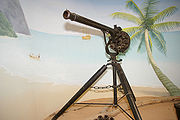
Puckle gun
Encyclopedia

James Puckle
James Puckle was an English inventor, lawyer and writer from London chiefly remembered for his invention of the Defence Gun, better known as the Puckle gun, a multi-shot gun mounted on a stand capable of firing up to nine rounds per minute...
(1667–1724) an English inventor, lawyer and writer.
Design and patent
It is a tripod-mounted, single-barreled flintlockFlintlock
Flintlock is the general term for any firearm based on the flintlock mechanism. The term may also apply to the mechanism itself. Introduced at the beginning of the 17th century, the flintlock rapidly replaced earlier firearm-ignition technologies, such as the doglock, matchlock and wheellock...
weapon fitted with a multishot revolving cylinder. It was intended for shipboard use to prevent boarding. The barrel was 3 foot (0.9144 m) long with a bore of 1.25 inches (31.8 mm). It had a pre-loaded cylinder which held 11 charges and could fire 63 shots in seven minutes—this at a time when the standard soldier's musket could at best be loaded and fired three times per minute.
According to the Patent Office of the United Kingdom, "In the reign of Queen Anne of Great Britain
Anne of Great Britain
Anne ascended the thrones of England, Scotland and Ireland on 8 March 1702. On 1 May 1707, under the Act of Union, two of her realms, England and Scotland, were united as a single sovereign state, the Kingdom of Great Britain.Anne's Catholic father, James II and VII, was deposed during the...
, the law officers of the Crown established as a condition of patent that the inventor must in writing describe the invention and the manner in which it works." This gun's patent was one of the first to provide such a description.
Two versions
Puckle demonstrated two versions of the basic design: one, intended for use against Christian enemies, fired conventional round bullets, while the second variant, designed to be used against the Muslim Turks, fired square bullets, which were considered to be more damaging and would, according to the patent, convince the Turks of the "benefits of Christian civilization."Production and operational use
The Puckle Gun drew few investors and never achieved mass production or sales to the British armed forces, mostly because British gunsmiths at the time could not easily make the weapon's many complicated components. One newspaper of the period sarcastically observed, following the business venture's failure, that the gun has "only wounded those who hold shares therein".John Montagu, 2nd Duke of Montagu
John Montagu, 2nd Duke of Montagu
John Montagu, 2nd Duke of Montagu, KG, KB, PC , styled Viscount Monthermer until 1705 and Marquess of Monthermer between 1705 and 1709, was a British peer...
, Master-General of the Ordnance
Master-General of the Ordnance
The Master-General of the Ordnance was a very senior British military position before 1855, when the Board of Ordnance was abolished.-Responsibilities:...
(1740-1749), purchased several for an ill-fated expedition in 1722 to capture St Lucia and St Vincent
Saint Vincent (island)
Saint Vincent is a volcanic island in the Caribbean. It is the largest island of the chain called Saint Vincent and the Grenadines. It is located in the Caribbean Sea, between Saint Lucia and Grenada. It is composed of partially submerged volcanic mountains...
.
Surviving examples
Two examples are on display at former Montagu homes: One at Boughton HouseBoughton House
Boughton House is a country house about north-east of Kettering off the A43 road near Geddington in Northamptonshire, England, which belongs to the Duke of Buccleuch.-History:...
and another at Beaulieu Palace.
There is a replica of a Puckle gun at Bucklers Hard
Bucklers Hard
Bucklers Hard is a hamlet situated on the banks of the Beaulieu River in the English county of Hampshire.- Overview :With its Georgian cottages running down to the river, Bucklers Hard is part of the 9,000 acre Beaulieu Estate...
Maritime Museum in Hampshire
Hampshire
Hampshire is a county on the southern coast of England in the United Kingdom. The county town of Hampshire is Winchester, a historic cathedral city that was once the capital of England. Hampshire is notable for housing the original birthplaces of the Royal Navy, British Army, and Royal Air Force...
.
Blackmore's British Military Firearms 1650–1850 lists "Puckle’s brass gun in the Tower of London" as illustration 77.

